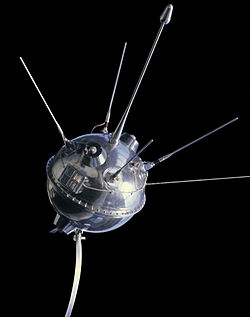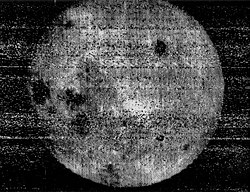

Missions to the Moon have been numerous and represent some of the earliest endeavours in space missions, with continuous exploration of the Moon beginning in 1959.
Contents
- 20th century
- 21st century
- Statistics
- Launches by decade
- Mission milestones by country
- Missions by organization/company
- Landing sites
- Future missions
- Funded and are under development
- Proposed but full funding still unclear
- Lunar rovers
- Unrealized concepts
- 1960s
- 1970s
- 2000s
- 2010s
- 2020s
- See also
- Notes
- References
- External links
The first partially successful lunar mission was Luna 1 in January 1959, which became the first probe to escape Earth's gravity and perform a flyby of another astronomical body, passing near the Moon. Soon after, the first Moon landing—and the first landing on any extraterrestrial body—was carried out by Luna 2, [1] which intentionally impacted the Moon on 14 September 1959. The far side of the Moon, permanently hidden from Earth due to tidal locking, was imaged for the first time by Luna 3 on 7 October 1959, revealing terrain never before seen.
Significant advances continued throughout the 1960s. In 1966, Luna 9 achieved the first controlled soft landing on the lunar surface, [2] followed later that year by Luna 10, the first spacecraft to enter orbit around the Moon. In 1968, the Zond 5 mission became the first to carry terrestrial lifeforms—specifically tortoises—on a circumlunar approach that brought them close to the Moon and returned them safely to Earth, demonstrating biological viability in deep space. [3]
The first crewed missions to the Moon were undertaken by the Soviet Union and the United States, forming the pinnacle of the Space Race. While the Soviet programme pivoted toward robotic sample return missions, the American Apollo program advanced through a sequence of increasingly complex missions. In December 1968, Apollo 8 became the first crewed spacecraft to orbit the Moon. On 20 July 1969, Apollo 11 accomplished the first crewed landing on the lunar surface, during which Neil Armstrong became the first human to set foot on the Moon. Concurrently, the Soviet Luna 15 robotic mission was also orbiting the Moon, marking the first known instance of simultaneous extraterrestrial operations by different nations.
Between 1969 and 1972, the United States carried out six successful Apollo landings, while the Soviet Union continued deploying uncrewed probes, including the Lunokhod programme—the first extraterrestrial rovers—and sample return missions through 1976. Following this period, there was a gap in dedicated lunar missions lasting until 1990. Since then, renewed interest in lunar exploration has seen additional missions conducted by a broader range of spacefaring entities. In chronological order following the Soviet Union and the United States, the Moon has been visited by Japan, the European Space Agency, China, India, Luxembourg, Israel, Italy, South Korea, the United Arab Emirates, Russia, and Pakistan.
In 2018, the far side of the Moon was targeted for the first time by a landing mission. On 3 January 2019, China's Chang'e 4 mission successfully landed in the Aitken basin, deploying the Yutu-2 rover, which commenced scientific operations on the unexplored lunar hemisphere. Five years later, China launched the Chang'e 6 sample return mission to the far side. Its lander touched down in Apollo crater on 1 June 2024 and collected the first lunar samples retrieved from the Moon's far hemisphere.
The first commercial mission to the Moon was the Manfred Memorial Moon Mission (4M), developed by LuxSpace, a subsidiary of the German aerospace company OHB AG, Launched on 23 October 2014 with the mission flying as a secondary payload aboard CNSA's Chang'e 5-T1 spacecraft. [4] [5]
The Moon has also been visited by a small number of spacecraft not dedicated to lunar study. Of these, four executed flybys using the Moon for gravity assist manoeuvres to alter their interplanetary trajectories. In addition, Explorer 49, a radio astronomy satellite launched by the United States in 1973, was placed into selenocentric orbit where the Moon itself served as a shield from terrestrial radio interference, enabling observations of deep-space radio signals.


